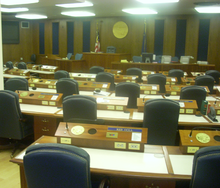Alaska House of Representatives
| Alaska House of Representatives | |
|---|---|
| Alaska Legislature | |
 |
|
| Type | |
| Type | |
|
Term limits
|
None |
| History | |
|
New session started
|
January 17, 2017 |
| Leadership | |
|
Majority Leader
|
Chris Tuck (D)
Since January 17, 2017 |
|
Minority Leader
|
|
| Structure | |
| Seats | 40 |
|
Political groups
|
Majority
Minority
|
|
Length of term
|
2 years |
| Authority | Article 2, Alaska Constitution |
| Salary | $50,400/year + per diem |
| Elections | |
|
Last election
|
November 8, 2016 (40 seats) |
|
Next election
|
November 6, 2018 (40 seats) |
| Redistricting | Alaska Redistricting Board |
| Meeting place | |
 |
|
| House of Representatives chamber Alaska State Capitol Juneau, Alaska |
|
| Website | |
| Alaska House of Representatives | |
Majority
Minority
The Alaska House of Representatives is the lower house in the Alaska Legislature, the state legislature of the U.S. state of Alaska. The House is composed of 40 members, each of whom represents a district of approximately 17,756 people per 2010 Census figures. Members serve two-year terms without term limits. With 40 representatives, the Alaska House is the smallest state legislative lower house in the United States.
The House convenes at the State Capitol in Juneau.
Members of the Alaska House of Representatives are responsible for a portion of the process of making and amending state law. The first step of the legislative process is filing a bill by giving it to the chief clerk of the Alaska House of Representatives. The chief clerk will then assign bills a number.
Bills are introduced and read the first time with the number, sponsor or sponsors, and the title of the bill and then referred to a committee(s). Committee chairs can choose whether or not hear a bill and committees can vote to approve a bill in its original form or make modifications through a committee substitute. Once bills or substitutes are approved, the legislation is referred to the next committee of assignment or to the Rules Committee, which can further amend the bill or assign it to the daily floor calendar.
Once a bill is scheduled on the floor, it appears on the calendar in Second Reading. The bill is again read by number, sponsor or sponsors, and title along with the standing committee reports. A motion is made on the floor to adopt any committee substitutes. Amendments can also be offered and voted on. Third Reading is where the motion is made to vote on the bill.
After final passage in the Alaska House of Representatives, a bill is engrossed and sent to the Alaska Senate to go through the same process of introduction, committee referral and three readings. Likewise, bills that have been approved on Third Reading in the Alaska Senate are engrossed and sent to the Alaska House of Representatives.
When a bill is not modified in the second house, it can be sent to the governor on Third Reading, through enrollment. If the bill is modified, the house of origin must vote to accept or reject amendments by the opposite house. A Fourth Reading, in the case of acceptance, will send the bill to the governor, through enrollment. If amendments are rejected, the bill can be sent to conference, where members of the Senate and House hash out a final version and send it to a Fourth Reading in both houses.
...
Wikipedia
